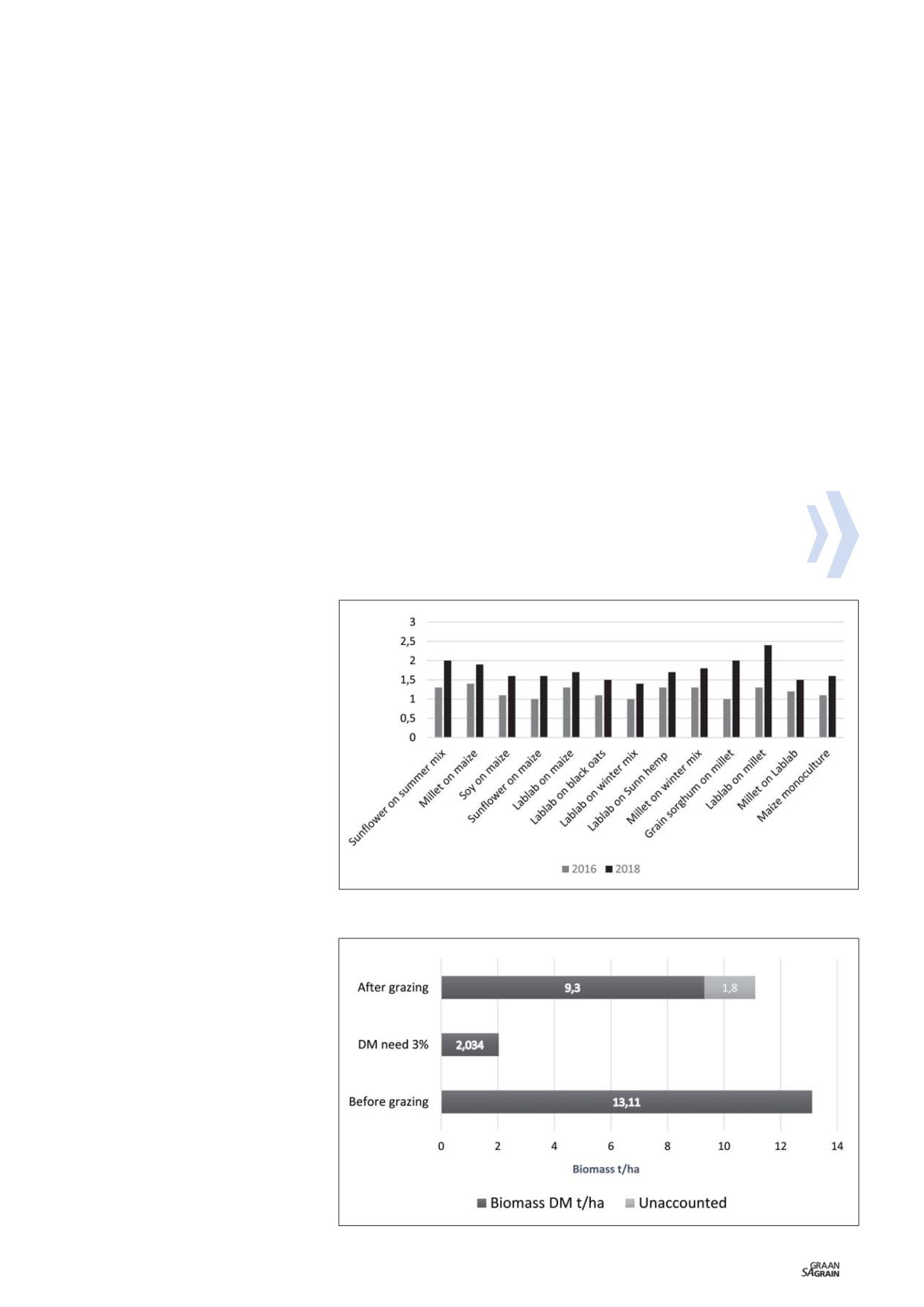

rotated with summer annual cover crops
had higher grain yields and water use ef-
ficiency values than those planted after
the winter cover crop’s annual treatments,
except for the winter cover crop mixture
treatment.
Effective rain for the past year (2017/2018)
resembles the amount received in the
2014/2015 season, when grain yields were
an average of 750 kg/ha for the season after
a good rain year. This past season the aver-
age maize grain was 7,8 t/ha with a water
use efficiency of 19,5 kg/mm of effective
rain received. Something is happening, but
what? Is soil organic matter perhaps the big
game changer here?
Maize leave samples were taken on 23 Feb-
ruary this year to determine the nutrient
content (
Photo 1
). Phosphorus and potas-
sium levels for the different treatments were
all above the required values given by the
maize information guide. In terms of nitro-
gen, the treatments of rye, black oats and
vetch were slightly below the required level.
The aim is to build-up soil health (or soil or-
ganic matter) to a level where microorgan-
isms freely release enough nutrients for a
harvest and where water use efficiency is
above 20 kg grain/mm of rain.
Soil organic matter
Through the process of photosynthesis,
plants obtain their carbon from the air (as
CO
2
) and not from the soil. This carbon is
then released from living plant roots as
exudates or ‘liquid carbon’, which supports
(feeds) the microbial activity required to
improve soil structure, increase macro and
micronutrient availabilities and enhance soil
water-holding capacity.
In turn, these factors improve plant pro-
ductivity. It’s a positive feedback loop. Pro-
ducers and researchers around the world
regard soil organic carbon or soil organic
matter as the universal metric to measure
soil health. These soil ecosystem func-
tions of soil organic matter are explained in
Table 1
on page 42.
The effect of soil organic matter on soil wa-
ter retention tends to be greater in coarse
textured compared to fine textured soils.
An increase in soil organic matter from 1%
to 3% can double the plant available water
in the sandy loam soils of the North West
Province.
One of the objectives of the trial at Ottos-
dal was to investigate which crops and crop
sequences will positively influence the se-
questration of soil carbon, since soil organic
matter building in the soils of the sub-trop-
ical, semi-arid environment of North West
Province is a major challenge.
Soil samples for selected treatments were
annually analysed using the Haney soil
health test, which includes soil organic mat-
ter and a range of other parameters (see
Graph 2
). These treatments represent all the
different functional groups in the trial, which
are grasses, legumes, cash crops and bras-
sicas.
Discussion
Maintenance of the soil organic carbon pool
at above the threshold/critical level of 1,1%
to 1,5% (1,89% - 2,58% soil organic matter)
in the root zone is essential to provide soil
functions and services (Lal, 2016).
At Humanskraal the highest value measured
for soil organic matter (2,4%) was under a
lablab (dolichos) and millet (babala) rota-
tion. The soil organic matter level almost
doubled (an increase from 1,3% - 2,4%)
over the past two years, reaching the critical
threshold level, which is remarkable in this
environment.
Plant material with a C:N ratio of 24 or high-
er, such as babala, will often immobilise soil
N, i.e. bacteria will use available N to break
the fibrous material down. Legumes fix at-
mospheric N in symbioses with rhizobial
bacteria, which eliminates immobilisation.
Treatments that include high yielding annual
grass crops such as babala and sorghum
also speed up soil organic matter build up.
It is clear that the summer mixture that in-
cludes both legumes and grasses can sup-
port soil organic matter sequestration by
supplying N as well as C.
For the cash crops the value of the sunflow-
er on summer mixtures (2%) holds promise,
as sunflower leaves low levels of residues
(<30% cover) before planting the next
crop. All treatments showed higher values
for soil organic matter over the two-year
period.
Integration trial
A Phospho Lipid Fatty Acid (PLFA) analy-
sis was also done to look at microbial di-
versity and function under these selected
treatments. The results revealed that after
employing CA principles for six years, soils
under cash crop soils still have a low soil or-
ganic matter (1% - 1,2%) content and poor
total microbial biomass. Also, no predators
such as protozoa and nematodes are pre-
sent in the soil. What could be the cause of
this undesirable situation?
Graph 2: Changes in percentage soil organic matter of the screening trial treatments, Ottosdal.
Graph 3: Biomass utilisation profile of the integration trial at Humanskraal, 2018.
41
November 2018
















